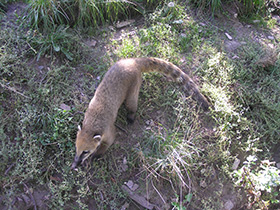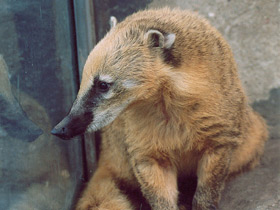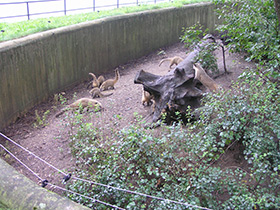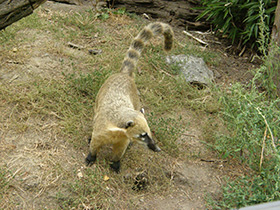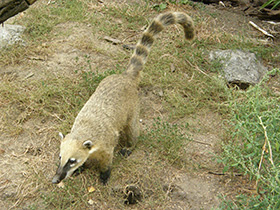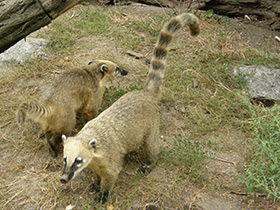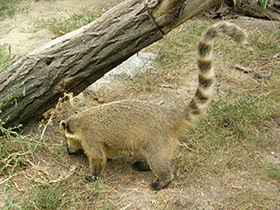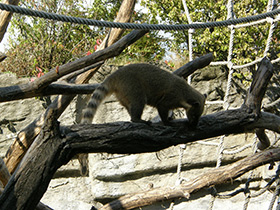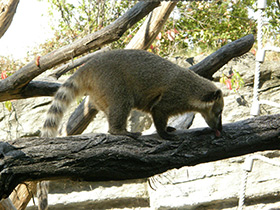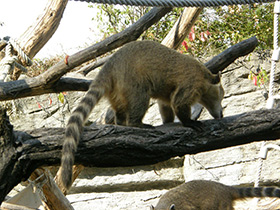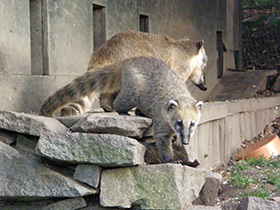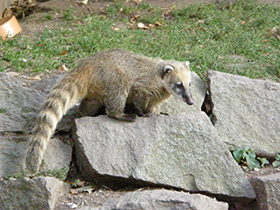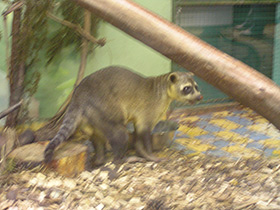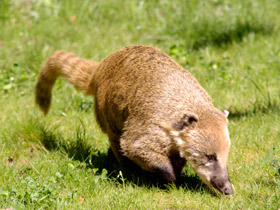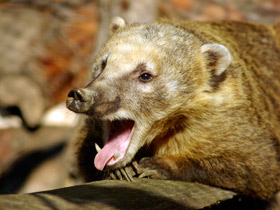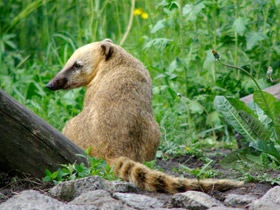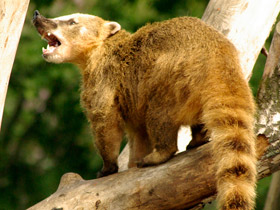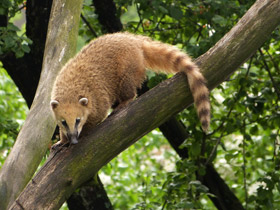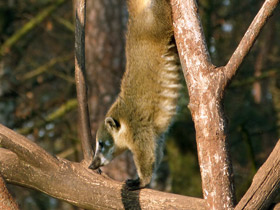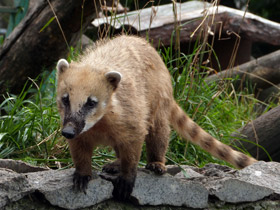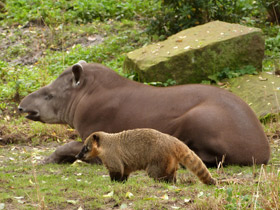The genus Nasua
The South American coati or the ring-tailed coati (Nasua nasua)
South American Coati видео
Nasua is a genus of coatis of the family Procyonidae. Two additional species of coatis, commonly known as mountain coatis, are placed in the genus Nasuella.
Description
Nasua, called Сoatids, is a genus of two species of small American omnivorous mammals of the family Procyonidae.
Nasua are easily recognised by their long, mobile snout, the tip of which extends well beyond the lower jaw. Inside this long "nose" are many sensitive receptors that allow the animal to detect odours. Numerous muscles give it a particularly flexible snout tip that allows the Nasua to inspect a wide range of crevices and find its prey in them. The Nasua is active during the day and spends much of its time combing the undergrowth and forest floor for food, turning leaves or digging for tasty treats such as invertebrates or fruit.
Social behaviour
Male Nasua lead a solitary lifestyle, while females live in well-organised groups called "flocks". The behavioural relationships of these sympatric animals are very complex and involve cooperation similar to that of primates. For example, "band" members often clean each other, care for each other's young and jointly defend themselves against potential predators.
The territories of single males may overlap by 72% and neighbours are often related. They do not defend their territories much, except in areas where food is plentiful, e.g. fruit trees may provoke aggression, usually of short duration.
The territories of "flocks" of females and their immature young may overlap by 66%, with only the central area being used exclusively by the "band" itself. During conflicts between individual "flocks", the Nasua immediately come to the aid of "their own", forming a kind of coalition. The extent of this behaviour depends on the age, social status and genetic kinship of the different members of the "gang".
Which animals are legitimate members of the Nasua "gang"?
We may assume that the bands are formed on the basis of kinship, but genetic studies show that in reality they also include some unrelated individuals.
Extensive field research in Panama has shown that these unrelated Nasua are more likely to be targeted by other animals and are forced to live on the outskirts of the "band", where they are more likely to fall prey to predators. However, the price to be paid is that it is advantageous for the Nasua to remain in the "band" and gain some benefits, such as access to food, rather than leaving the band to live on their own.
Reproduction
Nasua reproduction is always very synchronised. All females in the band, or even the entire population, come into heat at the same time, and mating takes place within a short period of two to four weeks.
Males may try to monopolise access to females by following the "band"; but research on the genetic make-up of offspring and their potential fathers has shown that, despite this, females can also mate with unrelated males.
Before giving birth, females leave the "band" and give birth to 3-4 single offspring. Females and their young do not return to the "flocks" for 5-6 weeks until the young Nasua are independent enough to follow their mother. The timing of the breeding season can vary markedly from one area to another and depends on the availability of food.
Nasua are classified by systematists as predators, but in reality they are omnivores and their diet consists mainly of fruits and invertebrates. Frugality and predator avoidance strategies have contributed to the characteristic social structure of these animals (solitary lifestyle of males and sociality of females). The "bands" can be quite large, up to 25 or more Nasua. A study in Panama showed that the average "band" size was 15 females, but this varied greatly depending on the season and food availability, as well as on the departure of pregnant females and their return.
Species
The genus Nasua includes two species
- Nasua narica LINNAEUS, 1766 - Coati;
- Nasua nasua LINNAEUS, 1766 - the Common Nasua.
One more species of badgers - mountain badger (Nasuella olivacea) - found only in the Andean valleys of the north-west of South America, belongs to a separate genus of mountain badgers (Nasuella). They are also easily domesticated by humans and can be pets.
The South American coati or the ring-tailed coati (Nasua nasua)
The South American coati (Nasua nasua), also known as the ring-tailed coati, is a coati species and a member of the raccoon family (Procyonidae), found in the tropical and subtropical parts of South America. An adult generally weighs from 2–7.2 kg (4.4–15.9 lb) and is 85–113 cm (33–44 in) long, with half of that being its tail. Its color is highly variable and the rings on the tail may be only somewhat visible, but its most distinguishing characteristic is that it lacks the largely white snout (or "nose") of its northern relative, the white-nosed coati.
Habitat and description
Nasua nasua is a species of carnivorous mammal of the family Procyonidae.
Nasua nasua inhabits the forests of South America, inhabiting the eastern Andes, southern and northern Argentina and Uruguay. Its body length varies between 80 and 130 cm, with the tail about half this length; the male weighs between 4 and 5 kg, and the female between 3.5 and 4.5 kg. A long, agile snout and strong claws on its forelegs are the tools with which the Nasua nasua searches for insects on the forest floor and digs the ground surface for lizards and spiders. Males feed quietly on their own and manage to catch more lizards and rodents than females and young animals kept in groups.
Behaviour
Social bonding between adult female Nasua nasua is often expressed through mutual grooming (brushing). Cohabitation benefits all members of the "gang", but the young in particular. Nasua nasua adults and hatchlings surround the young, watch for approaching predators and chase them away together if necessary. Other members of the "gang" clean the young almost as often as the mother, and are even allowed to look after them.
Taxonomy
Viverra nasua was the scientific name proposed by Carl Linnaeus in 1766 for a red coati specimen. It was subordinated to the genus Nasua. As of 2005, 13 subspecies were recognized:
- Nasua nasua nasua (Linnaeus, 1766);
- Nasua nasua spadicea Olfers, 1818;
- Nasua nasua solitaria Schinz, 1823;
- Nasua nasua vittata Tschudi, 1844;
- Nasua nasua montana Tschudi, 1844;
- Nasua nasua dorsalis Gray, 1866;
- Nasua nasua molaris Merriam, 1902;
- Nasua nasua manium Thomas, 1912;
- Nasua nasua candace Thomas, 1912;
- Nasua nasua quichua Thomas, 1912;
- Nasua nasua cinerascens Lönnberg, 1921;
- Nasua nasua aricana Vieira, 1945y;
- Nasua nasua boliviensis Cabrera, 1956;

















